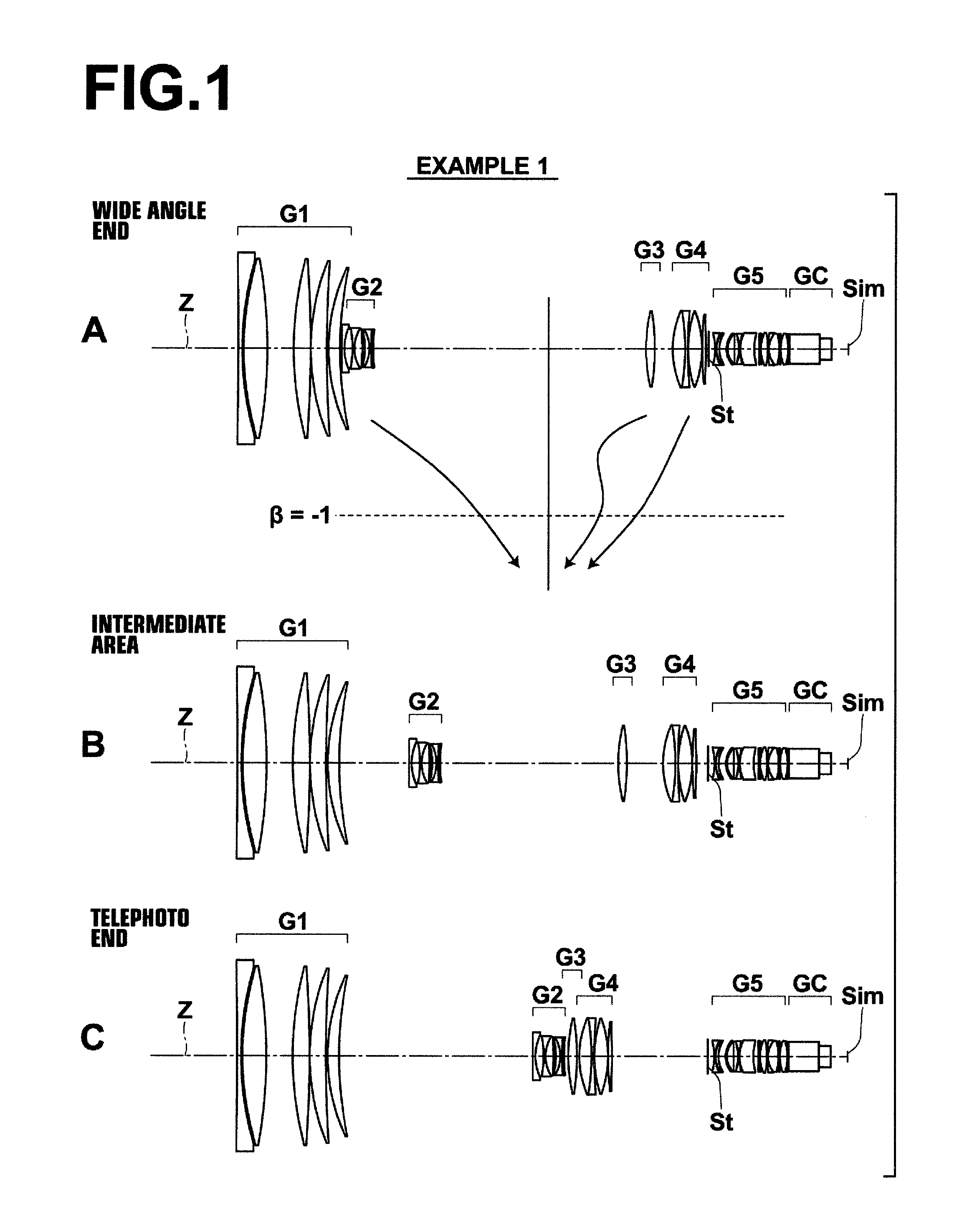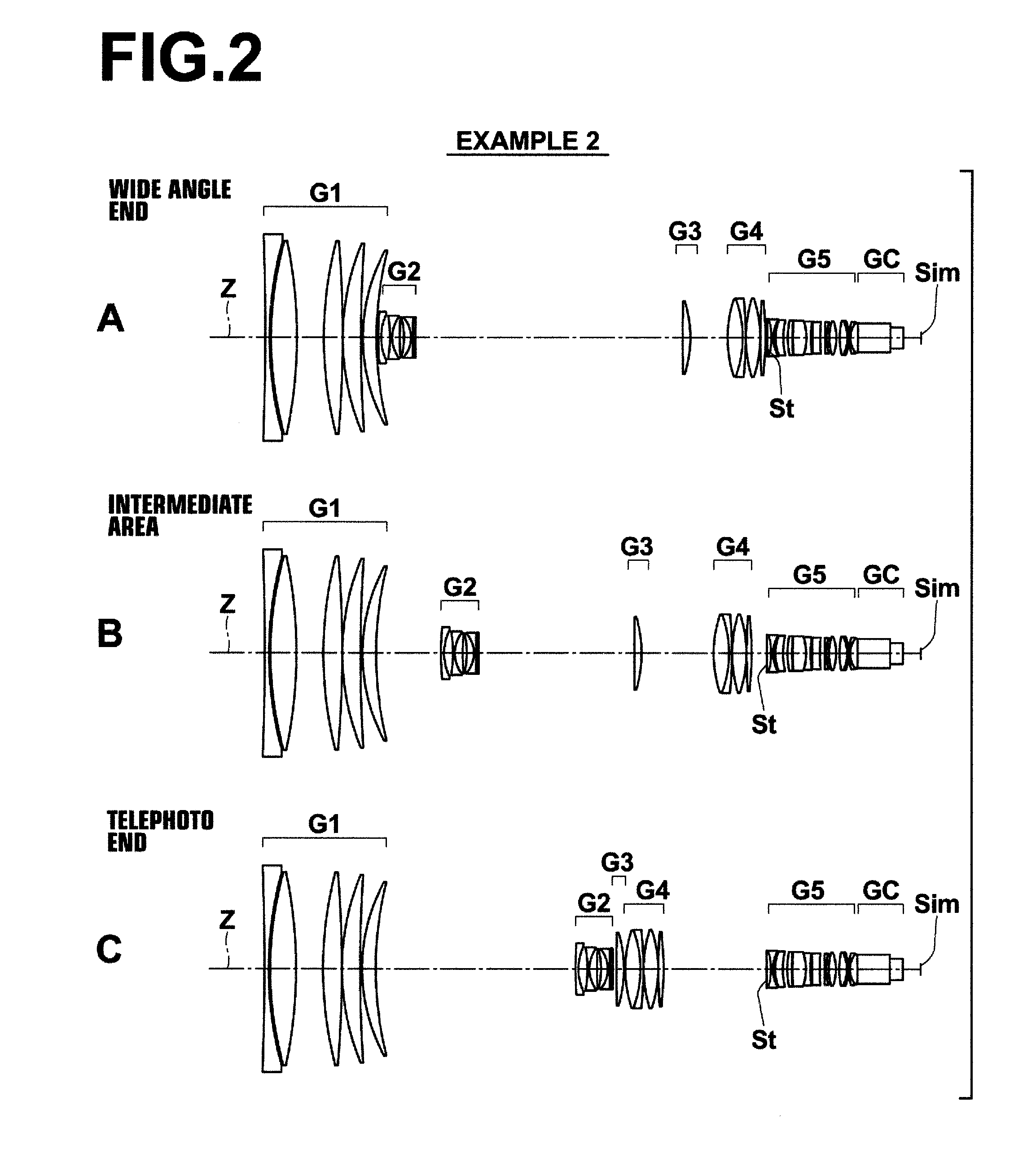Zoom lens and imaging apparatus
a zoom lens and imaging apparatus technology, applied in the field of zoom lens and imaging apparatus, can solve the problems of difficult widening of increased weight of the lens system, and increased difficulty in widening so as to enhance the advantageous effect, widen the angle of view, and favorably correct the variations of the imaging plane
- Summary
- Abstract
- Description
- Claims
- Application Information
AI Technical Summary
Benefits of technology
Problems solved by technology
Method used
Image
Examples
example 1
[0109]The cross sectional view of the lens of Example 1 is shown in FIG. 1. Detailed configurations thereof are shown in FIGS. 7 through 9. FIG. 7 shows detailed configurations of the first lens group G1 and the second lens group G2, FIG. 8 shows detailed configurations of the third lens group G3 and the fourth lens group G4, and FIG. 9 shows detailed descriptions from the fifth lens group G5 to the image formation surface Sim.
[0110]In Example 1, the first lens group G1 is of a five-lens configuration including lenses L1 through L5, the second lens group G2 is of a six-lens configuration including lenses L21 through L26, the third lens group G3 is of a one-lens configuration including a lens L31, the fourth lens group G4 is of a four-lens configuration including lenses L41 through L44, and a fifth lens group G5 is of a thirteen-lens configuration including an aperture stop St and lenses L51 through L63.
[0111]Lens data of the zoom lens according to Example 1 is shown in Table 1, the ...
example 2
[0122]The cross sectional view of lenses in Example 2 is shown in FIG. 2, and detailed configurations thereof are shown in FIGS. 10 through 12. FIG. 10 shows the detailed configuration of the first lens group G1 and the second lens group G2, FIG. 11 shows the detailed configurations of the third lens group G3 and the fourth lens group G4, and FIG. 12 shows the detailed configuration from the fifth lens group G5 to the image formation surface Sim.
[0123]In Example 2, the first lens group G1 is of a five-lens configuration including lenses L1 through L5, the second lens group G2 is of a six-configuration including lenses L21 through L26, the third lens group G3 is of a one-lens configuration including L31, the fourth lens group G4 is of a four-lens configuration including lenses L41 through L44, and the fifth lens group G5 is of a twelve-lens configuration including an aperture stop St and lenses L51 through L62.
[0124]Lens data of the zoom lens according to Example 2 is shown in Table ...
example 3
[0125]The cross sectional view of lenses in Example 3 is shown in FIG. 3, and detailed configurations thereof are shown in FIGS. 13 through 15. FIG. 13 shows the detailed configuration of the first lens group G1 and the second lens group G2, FIG. 14 shows the detailed configurations of the third lens group G3 and the fourth lens group G4, and FIG. 15 shows the detailed configuration from the fifth lens group G5 to the image formation surface Sim.
[0126]In Example 3, the first lens group G1 is of a five-lens configuration including lenses L1 through L5, the second lens group G2 is of a six-lens configuration including lenses L21 through L26, the third lens group G3 is of a one-lens configuration including a lens L31, the fourth lens group G4 is of a four-lens configuration including lenses L41 through L44, and the fifth lens group G5 is of a thirteen-lens configuration including an aperture stop St and lenses L51 through L63.
[0127]Lens data of the zoom lens according to Example 3 is s...
PUM
 Login to View More
Login to View More Abstract
Description
Claims
Application Information
 Login to View More
Login to View More - R&D
- Intellectual Property
- Life Sciences
- Materials
- Tech Scout
- Unparalleled Data Quality
- Higher Quality Content
- 60% Fewer Hallucinations
Browse by: Latest US Patents, China's latest patents, Technical Efficacy Thesaurus, Application Domain, Technology Topic, Popular Technical Reports.
© 2025 PatSnap. All rights reserved.Legal|Privacy policy|Modern Slavery Act Transparency Statement|Sitemap|About US| Contact US: help@patsnap.com



